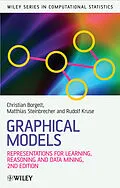Graphical models are of increasing importance in applied statistics, and in particular in data mining. Providing a self-contained introduction and overview to learning relational, probabilistic, and possibilistic networks from data, this second edition of Graphical Models is thoroughly updated to include the latest research in this burgeoning field, including a new chapter on visualization. The text provides graduate students, and researchers with all the necessary background material, including modelling under uncertainty, decomposition of distributions, graphical representation of distributions, and applications relating to graphical models and problems for further research.
Autorentext
Christian Borgelt, is the Principal researcher at the European Centre for Soft Computing at Otto-von-Guericke University of Magdeburg.
Rudolf Kruse, Professor for Computer Science at Otto-von-Guericke University of Magdeburg.
Matthias Steinbrecher, Department of Knowledge Processing and Language Engineering, School of Computer Science, Universitätsplatz 2,?Magdeburg, Germany.
Klappentext
The use of graphical models in applied statistics has increased considerably in recent years. At the same time the field of data mining has developed as a response to the large amounts of available data. This book addresses the overlap between these two important areas, highlighting the advantages of using graphical models for data analysis and mining. The Authors focus not only on probabilistic models such as Bayesian and Markov networks but also explore relational and possibilistic graphical models in order to analyse data sets.
- Presents all necessary background material including uncertainty and imprecision modeling, distribution decomposition and graphical representation.
- Covers Markov, Bayesian, relational and possibilistic networks.
- Includes a new chapter on visualization and coverage of clique tree propagation, visualization techniques.
- Demonstrates learning algorithms based on a large number of different search methods and evaluation measures.
- Includes a comprehensive bibliography and a detailed index.
- Features an accompanying website hosting exercises, teaching material and open source software.
Researchers and practitioners who use graphical models in their work, graduate students of applied statistics, computer science and engineering will find much of interest in this new edition.
Inhalt
Preface.
1 Introduction.
1.1 Data and Knowledge.
1.2 Knowledge Discovery and Data Mining.
1.3 Graphical Models.
1.4 Outline of this Book.
2 Imprecision and Uncertainty.
2.1 Modeling Inferences.
2.2 Imprecision and Relational Algebra.
2.3 Uncertainty and Probability Theory.
2.4 Possibility Theory and the Context Model.
3 Decomposition.
3.1 Decomposition and Reasoning.
3.2 Relational Decomposition.
3.3 Probabilistic Decomposition.
3.4 Possibilistic Decomposition.
3.5 Possibility versus Probability.
4 Graphical Representation.
4.1 Conditional Independence Graphs.
4.2 Evidence Propagation in Graphs.
5 Computing Projections.
5.1 Databases of Sample Cases.
5.2 Relational and Sum Projections.
5.3 Expectation Maximization.
5.4 Maximum Projections.
6 Naive Classifiers.
6.1 Naive Bayes Classifiers.
6.2 A Naive Possibilistic Classifier.
6.3 Classifier Simplification.
6.4 Experimental Evaluation.
7 Learning Global Structure.
7.1 Principles of Learning Global Structure.
7.2 Evaluation Measures.
7.3 Search Methods.
7.4 Experimental Evaluation.
8 Learning Local Structure.
8.1 Local Network Structure.
8.2 Learning Local Structure.
8.3 Experimental Evaluation.
9 Inductive Causation.
9.1 Correlation and Causation.
9.2 Causal and Probabilistic Structure.
9.3 Faithfulness and Latent Variables.
9.4 The Inductive Causation Algorithm.
9.5 Critique of the Underlying Assumptions.
9.6 Evaluation.
10 Visualization.
10.1 Potentials.
10.2 Association Rules.
11 Applications.
11.1 Diagnosis of Electrical Circuits.
11.2 Application in Telecommunications.
11.3 Application at Volkswagen.
11.4 Application at DaimlerChrysler.
A Proofs of Theorems.
A.1 Proof of Theorem 4.1.2.
A.2 Proof of Theorem 4.1.18.
A.3 Proof of Theorem 4.1.20.
A.4 Proof of Theorem 4.1.26.
A.5 Proof of Theorem 4.1.28.
A.6 Proof of Theorem 4.1.30.
A.7 Proof of Theorem 4.1.31.
A.8 Proof of Theorem 5.4.8.
A.9 Proof of Lemma .2.2.
A.10 Proof of Lemma .2.4.
A.11 Proof of Lemma .2.6.
A.12 Proof of Theorem 7.3.1.
A.13 Proof of Theorem 7.3.2.
A.14 Proof of Theorem 7.3.3.
A.15 Proof of Theorem 7.3.5.
A.16 Proof of Theorem 7.3.7.
B Software Tools.
Bibliography.
Index.
